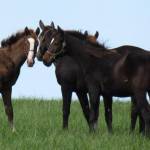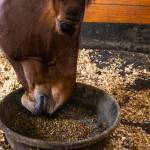Essential Dietary Minerals for Young, Growing Horses

The goal of raising performance horses is to produce sound athletes. One potential pitfall in raising this type of horse is unsoundness resulting from developmental orthopedic disease (DOD), a term that includes all general growth disturbances resulting from any alteration in normal bone formation. DOD has many manifestations in growing horses including physitis, wobbler syndrome, angular or flexural limb deformities, and osteochondrosis.
The factors thought to influence the occurrence of DOD are genetics, rapid or irregular growth, nutritional imbalances, environment, and trauma to the metaphyseal growth plate or articular cartilage. With nutrition being one potential factor in DOD, adequately fortifying and properly balancing the diets for young growing horses is very important. To properly fortify and balance a diet for a young growing horse, it is essential to have an understanding of which nutrients are most critical for proper skeletal growth. With so many different feedstuffs available, each with a slightly different nutrient profile, it is critical to have a working knowledge of feeding practices including the amount and type of feed provided and the expected growth rate of the horse.
All growing animals require energy, protein (amino acids), minerals, and vitamins. However, the actual nutrients which are considered in balancing diets for various farm animals are very different. In horses, the list of critical nutrients for growth is fairly small. The most critical minerals for growth of young horses are the macrominerals calcium and phosphorus and the microminerals copper and zinc.
Calcium is the first mineral often considered in the diets of young horses. Calcium makes up about 35% of bone structure, with approximately 99% of the calcium in the body found in the bones and teeth. Calcium is also involved in other body functions including muscle contraction and blood clotting mechanisms. Inadequate calcium intake by the developing foal can lead to rickets, which is characterized by poor mineralization of the osteoid tissue and the probability of enlarged joints and crooked long bones. The scientific data pointing to the ill-effects of a calcium-deficient diet have also been reported in the field. A negative linear relationship between dietary calcium intake and perceived severity of DOD in young horses has been seen. Excess calcium has also been fed to young horses. In one study, feeding five times the calcium requirement was not detrimental provided the level of phosphorus in the diet was adequate.
Phosphorus is also a critical mineral for proper skeletal development. Phosphorus is often considered with calcium since it also is a major component of bone, making up 14 to 17% of the skeleton. Two major problems can exist with growing horses relative to phosphorus supplementation. The first is inadequate phosphorus in the diet. A simple phosphorus deficiency can result in DOD and bone demineralization. The second condition is excessive dietary phosphorus, a situation in which phosphorus concentration is actually greater than calcium concentration. In this case, phosphorus interferes with calcium absorption.
Copper is required by growing horses as a component of several copper-dependent enzymes involved with elastin and collagen formation. Young growing horses with inadequate copper intake do not suffer from a slow growth rate; instead, normal or rapid growth continues but without adequate copper for normal bone and cartilage development. The end result is foals with decreased bone density leading to DOD. Research has shown that the rate of copper absorption by the horse decreases with increasing copper intake, giving horses a high tolerance to excess copper ingestion.
Zinc is required as a component of many metalloenzymes involved in protein and carbohydrate metabolism. Low zinc concentration has been correlated with an increased incidence of DOD in growing horses.
By selecting a feed designed and formulated for young, growing horses, owners are usually able to feel confident that they are providing the proper level of essential minerals to the young horses in their care.








